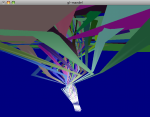If a function is pretty fun, why not do it again?
My post yesterday about the Mandelbrot set got me thinking again about iterated functions. With the Mandelbrot set, you start with some complex number and with
. Then, you generate
by doing
.
Here’s another way to write this iteration. Let . Let
and
and
. In general, we write
to mean
when there are
copies of
. It is easy to verify then that
.
The Jam
 For that post, I generated the image linked at the right here. Each level of that image represents one iteration of
For that post, I generated the image linked at the right here. Each level of that image represents one iteration of with each strand made up of four different
functions with neighboring
‘s.
One of the annoying things about that image is that I went directly from one iteration to the next. I had pondered using conventional splines or other polynomials to interpolate between iterations in an effort to smooth out the transitions. I didn’t go to the trouble for it though because any straightforward interpolation would be every bit as fake as the linear version. There is no provision in the iteration for unless
is a non-negative integer.
Now the question is, can we fake one? Can we make some other function so that
?
Faking easy functions
Let’s start with an easier function. In fact, let’s start with the easiest function: . It is obvious that
for all positive integers
. As such, if we let
, it is trivially true that
. But, that was too easy.
Maybe will be harder? No. Again,
.
Faking translations
Let’s move up to something a little trickier. Let’s say that for some constant
. Now, we see that
. What are we going to try for
then? Let’s try the obvious:
. Hooray!
. So, it makes sense then to think of
as
. Similarly, we can think of
as
for all positive integers
. In this way, we can make values
for any positive rational number
.
Faking translations with scaling
Now, we’re cooking. Let’s up the ante. Let’s try . What are we going to try for
then? Let’s guess we can still use roughly the same form:
. Then,
. If we want
, then we need
and
. This means that
and
. In particular, notice that if
and
are both real numbers with
less than zero, then
is pure imaginary and
is complex.
TTFN
I have much more to say about iterated functions, but I will save some for the next iteration. Next time, I will start with that last case and calculate for rational
.


